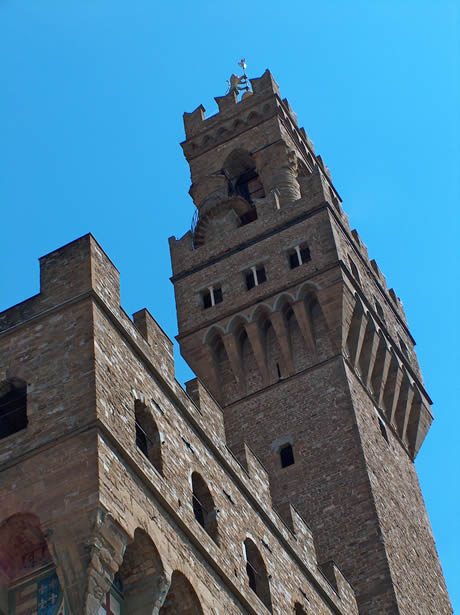Palazzo Vecchio

Religious establishments and museums aside, Florence features a wealth of historic edifices which match – and sometimes even exceed – by both grandness and artistic patrimony any of the formerly mentioned landmarks of the capital of Tuscany. Visiting the palaces of Florence is one of the chief manners of understanding the historic trajectory of the city.
The Palazzo Vecchio (the Old Palace) is one of the most important political buildings in Florence, its chiefdom in the political life of the city being, amongst others, substantiated by its former appellatives: Palazzo della Signoria, Palazzo del Popolo, Palazzo dei Priori and Palazzo Ducale. By force of these considerations, one can easily imagine the historic trajectory of the palace could not but be linked, at least partially, to the name of the Medici family. Indeed, the palace was built between 1299 and 1322 by Arnolfo di Cambio, the original architect of the Cathedral of Santa Maria dei Fiori, upon the wish of the Florentine people.

The Medici family, subsequently to their ascension in the politics of Florence, became entitled to use the palace as residence and headquarters. The current name of the palace dates back to the moment when the Medici moved south of the Arno River in the Palazzo Pitti (in mid 16th century); hence, the former Palazzo della Signoria became the Palazzo Vechio, the only landmark reminding of the institution of Signoria being homonymous square, Piazza della Signoria, where the palace is located. The fortress-like palace is overtopped by an impressive clock tower which jets from the crenellated roof of the Palazzo Vecchio, but the inner artistic asset of the edifice exceeds it outer Gothic look. Plenty of Renaissance and Mannerist artists have been summoned to share in to the embellishment of the palace, starting with Leonardo da Vinci and Michelangelo (who have, at least in part, failed to complete their task for various reasons), and ending with Ridolfo del Ghirlandaio and Domenico Ghirlandaio, Vasari, Michelozzo, Andrea del Verrocchio, Andrea del Sarto, Giambologna, Bartolomeo Ammannati, Cellini, Botticelli for instance.
Nowadays the Palazzo Vecchio services as City Hall, but most of it has been turned into a museum-like establishment, given the huge artistic patrimony it is populated with. The palace features three courtyards. The first is highlighted by Andrea del Verrocchio’s Putto with Dolphin (in the center of the courtyard) – now a replica, the original being sheltered in one of the chambers on the second floor of the palace – and by the bordering walls frescoed by Vasari. The second courtyard owes a lot, architecturally speaking, to Cronaca, whereas the third one impresses by the striking stairs designed, again, by Vasari. In order to honor Vasari’s contribution to the patrimony of the Palazzo Vecchio, the monumental corridor linking this palace to the Uffizi Gallery and the Palazzo Pitti, built by Vasari for the use of the Medici, has been named the Vasari Corridor. Paradoxically, the most arresting chamber of the Palazzo Vecchio, that is, the Salone dei Cinquecento, was not built under the dominion of the Medici, but of Savonarola, who commissioned Simone del Pollaiolo to design it.
Besides its dimensions, this chamber fetches by the florid artistic assets, ranging from frescoes and paintings to sculptures. Highlights refer to Michelangelo’s Genius of Victory, allegedly built to another end, but eventually brought here. Tourists should keep in mind the current exhibit is but a replica, the original having been moved to the Bargello Museum. However, Vasari is the one who has contributed most extensively to the decoration of this room, the panels embellishing its ceiling being but a taste of his heritage. The second floor of the palace hosts a large number of rooms suggestively named after their main highlights, the link between the ground floor and the second one being materialized by a monumental staircase, it too designed by Vasari. Tourists should focus their attention on several chambers once on the second floor, such as the Ceres Room, the Green Room, the Jupiter Room, the Hercules Room and the Room of the Sabine, not to mention the Saturn Terrace and the Lion House, though the Old Chancellery can also represent an objective, especially for those interested in the life and work of Machiavelli, since this very room used to be Machiavelli’s office while he served Florence as Secretary.
Obviously, the Palazzo Vechio is an undeniable spot on the tourist circuit of Florence, and the fact it is historically and from an infrastructural point of view linked to the Uffizi and the Palazzo Pitti enhances even more its tourist worth.
- Name:
- Palazzo Vecchio
- Address:
- Piazza della Signoria, Florence
- Telephone number:
- 0039 (0)55 276 8325
- Website:
- www.museicivicifiorentini.it